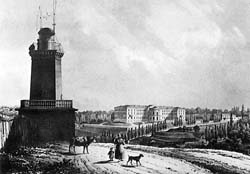Young Noble Ladies, a Half Forgotten Page In Kyiv’s Recent Past

The Kyiv Institute for Noble Joung Ladies was something between an elementary school and institution of higher education. Its alumnae received esthetic and ethical education, as well as the right to educate gentry and merchant children.
At first this establishment was in the building of Fieldmarshal Osten-Sachen (approximately where today’s Kyiv Hotel is situated). A new building was built in 1838-1842 under the project of outstanding architect Beretti. Until recently it was called the October Palace of Culture.
The statute allowed the Institute to admit the girls of noble (gentry) origin and, from 1852 on, also the daughters of honorary citizens as well as first and second guild merchants. Tuition was 350 silver rubles in the early twentieth century. The parents or relatives of an applicant were to submit a whole series of documents to the admission board, such as a letter of application to the lady principal; certificates of nobility and baptism, health, and smallpox vaccination; documents on elementary education received; as well as a written pledge to pay the tuition fee on time.
The institute enrolled girls aged eight to thirteen and a half. The full academic course lasted for six or — plus the preparatory class — seven years. The course was divided into three two-year grades.
Upon entering the institute, the noble girls were required to have 24 gowns, 6 sheets, 12 pairs of thread- knit stockings, 12 white cloth handkerchiefs, 6 towels, 4 napkins, a tableware set of one table and one silver spoon, a common knife, and a fork. The institute’s statute required payment for textbooks and clothes.
The institute taught the Law of God for Orthodox and Roman-Catholic girls (many students came from families of the Polish nobility); Russian language and literature; history; geography; arithmetic; the basic knowledge of physics and mineralogy; the Polish, German, and French languages; drawing and printing; music, church singing, dancing; embroidery; and home economics.
In the third, final, grade classes were given by Kyiv St. Vladimir Imperial University professors, while the first and second grades were conducted by the best teachers of Kyiv high schools. Among them were the well-known scholars N. Bunge, V. Shulgin, M. Kostomarov, M. Lysenko. Prominent concert performers Ye. Yelchanova, O. Doller, O. Tolberg, opera singers Y. Rafilovich and O. Menshikova, as well as poetess N. Zabello (Natalia Zabila) gained musical education at the Institute.
All noble girls applying to the institute took entrance exams and were placed in class according to the knowledge they demonstrated. To be promoted to a senior grade, they had to pass exams in Catechism and Sacred History, grammar, and the three languages mentioned; the girls were supposed to be fluent in these languages, be proficient in the four arithmetic operations with integers and fractions, have some basic knowledge in geography and history, know concise information on all the cardinal points and major European states, and be able to answer questions about ancient history and mineralogy.
Private lessons in music and singing were available for an additional fee of 30 rubles. Only the very gifted were eligible for free half an hour weekly lessons. Each graduate was awarded a certificate. Undoubtedly, education obtained at the Institute of Noble Maidens helped the girls in their future life.
After the Bolsheviks seized power in Kyiv, they shut down this institution. The institute’s premises housed the notorious People’s Commissariat of Internal Affairs of the Ukrainian SSR in the 1930s and the Gestapo during the Nazi occupation. Known as the October Palace after the victory over Germany, the building is now the seat of the International Center for Culture and the Arts.






